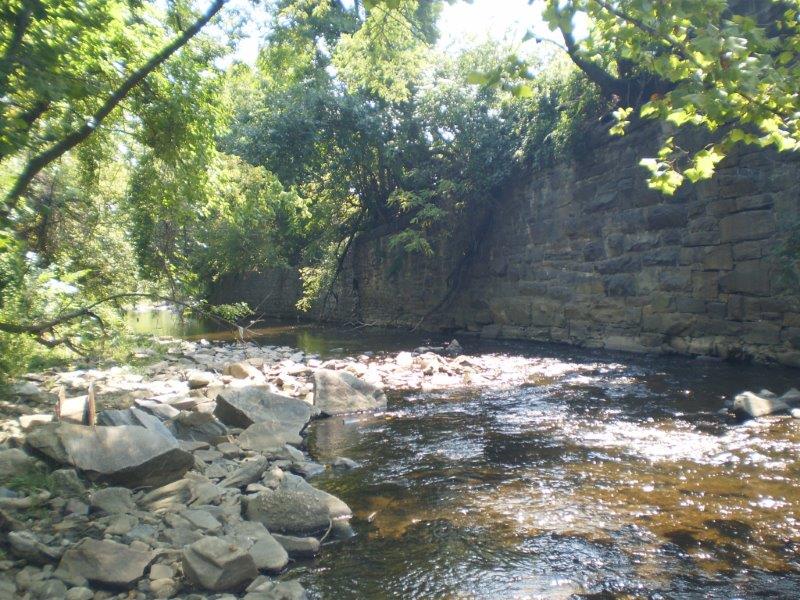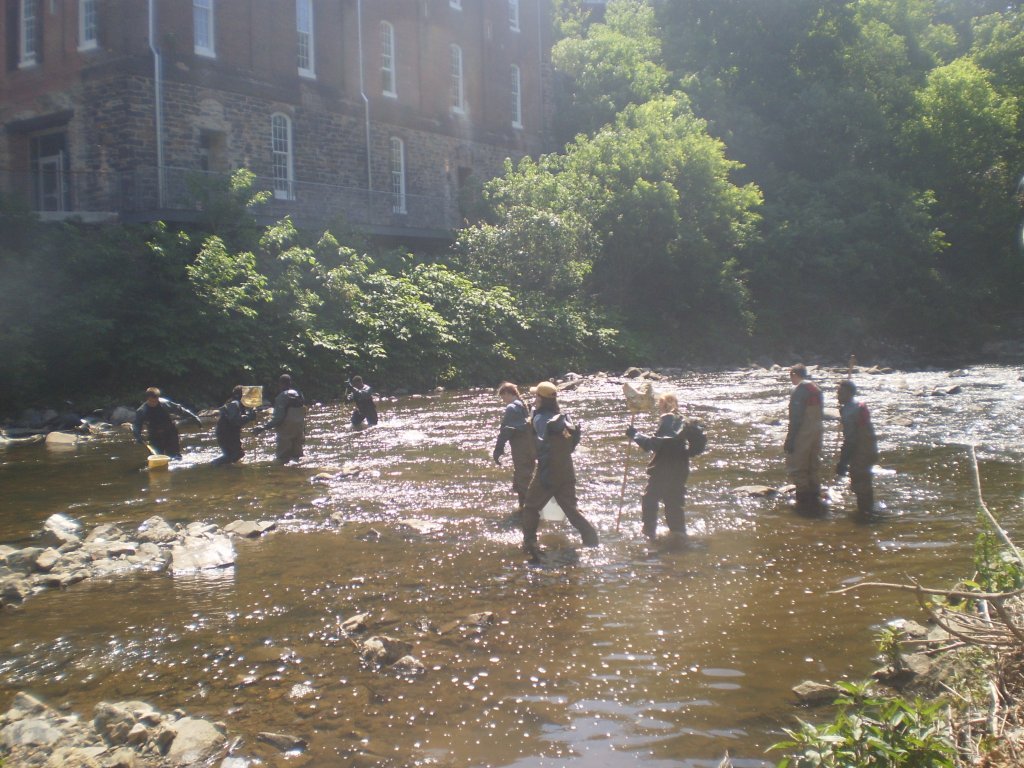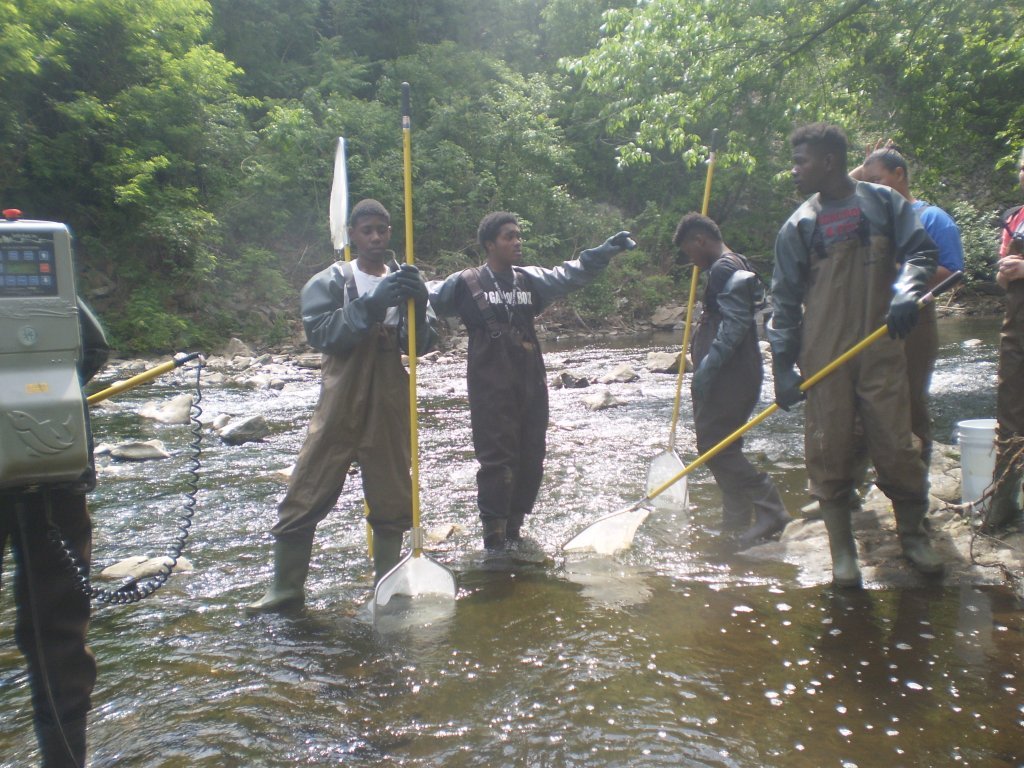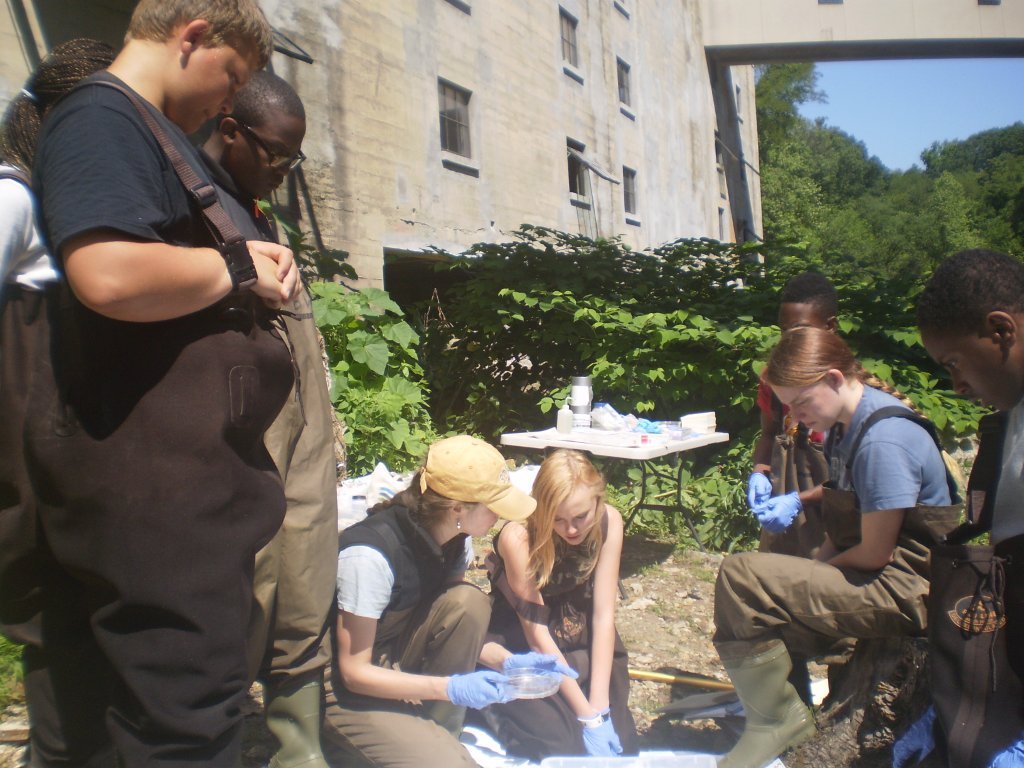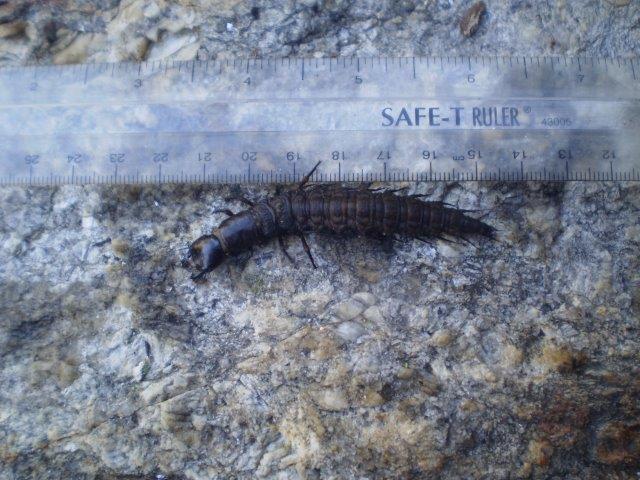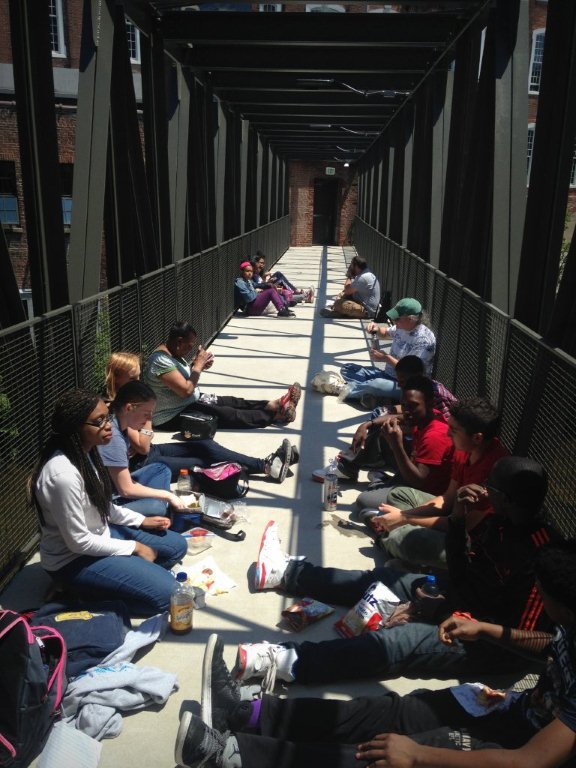Students from Independence Local looking for invertebrates in the Jones Falls (5-22-15)
Toadpoles! Actually the tadpole larval stages of toads in the fringes of the Jones Falls (photo – Chris Bellmeyer)
Looking down from the bridge at a fish nest constructed of light colored pebbles, possibly that of the cutlips minnow (photo- Chris Bellmeyer)
Electrofishing team from Independence Local, 5-15-15
Identifying macros – 5-22-15
The hellgrammite larva, found in the Jones Falls – note the size!
part of the electrofishing haul from Jones Falls 5-22-15
The stream study team returned to Mill Number One againon May 15th and May 22nd to conduct further investigations into the health of the lower Jones Falls. On both days we had the help of teacher Gwen Mullens’ environmental science classes from Independence School Local, located just up the road in Hampden. Together with the information from the April 1st stream study with students from ACCE, these give us a nice snapshot of the condition of the Jones Falls at this location. The overall conclusion is that, while the Jones Falls is contaminated to be sure, it’s not preventing a large number of things from living in it, and thus represents a vibrant slice of wildlife in this deeply urban location.
For starters, we had just great weather on both of the stream study days – sunny with a nice cool breeze. Water conditions were also ideal, with the stream being relatively clear and low in flow. To do electrofishing studies the water needs to be in this condition, or you can’t wade safely and see the fish that you need to scoop up.
In terms of fish collected we added a few more species to our list. The added species in addition to the April 1st collection included satinfin shiner, yellow bullhead (a type of catfish), fathead minnow, and spotfin shiner. With the exception of satinfin shiner, none of these species are particularly sensitive to pollution. However, the more species that we have in the stream, the better off the ecosystem. The greater the number of species, the higher the biodiversity, and the more moving parts the ecosystem has.
On May 15th we were able to observe some nesting behavior from the bridge across the stream where the class ate lunch. Small nests built out of pebbles were visible on the stream bottom, and fish could be seen defending the nest aggressively (pictured above). While we could not get a positive ID on the fish using the nests, one primary candidate for the species building these nests is the cutlips minnow. We found a good number of cutlips minnows in our samples and this is a species which indeed constructs nests up to 18 inches across, about the size of the ones that we saw. The kinds of species that construct nests out of gravel and sand are called lithophilic spawners (lithophilic means ‘rock loving’). This category of fish has long been known to be susceptible to urbanization of watersheds, and in Baltimore the fish species which have been most impacted (extirpated or reduced) apparently fall into this category. One of the biggest problems in urban watersheds is brief, high intensity flow following rainfall which disrupts nests of these kinds of species, even under pristine conditions. In urbanized watersheds like the Jones Falls the flows are higher and more frequent, and that makes it a lot tougher for these species to reproduce successfully. That’s the reason it’s a good sign to see a species like the cutlips minnow hanging on in the Jones Falls. Some species, like the river chub which builds huge pebble mound nests, are apparently absent from urbanized streams like the Jones Falls, possibly for this reason. The restoration activities that Blue Water Baltimore does, such as tree planting, rain barrel installation, and removing impervious surfaces, are baby steps in the right direction for getting these flows under control. And if enough baby steps are taken, who knows what this habitat will be suitable for?
One of the most important aspects of the stream study was our look at benthic macroinvertebrates, or macros for short. These are the invertebrates that live on and under the rocks and in the substrate of the stream. These are particularly important to look at when assessing the health of a stream because there are so many species, many of which have a particular range of tolerance to pollution and disturbance. There are species which are extremely sensitive to pollution, those with a great deal of tolerance, and those which fall somewhere in between. Since they live in the stream all of the time, what you find in a stream reflects conditions of that stream over the whole life of the invertebrate, not only the day you were there. Finding a sensitive species of invertebrate in a stream is therefore a really good sign that the stream is not such a bad place to live. The stream studies did find pollution tolerant species, like Oligochaetes (segmented worms), red chironomids (midge larvae), Isopods, and Physid and Ancylid snails. However, we also found a good deal of species with only moderate sensitivity to pollution. One of the most impressive of these was the very-cool-named Hellgrammite, pictured above. They are part of a small order of insects known by the equally impressive name Megaloptera. It has always struck me that these would make great names for heavy metal bands, and there’s probably a really good logo somewhere in there as well. These are absolutely huge invertebrate larvae which can grow up to 8 inches long in some species! They have impressive looking mouthpart pincers, though I have never really been bitten by these things. They apparently use them to good effect as they are definitely predators. Anything like that that isn’t a predator would truly be a surprise. When they metamorph they change into a giant flying insect with very long clear wings (4 inch wingspan is not out of the question) and a hellgrammite head, called a dobsonfly. I’ve seen the adults pop up unexpectedly at shopping centers and homes that are close to water. I wouldn’t be surprised if a good number of Hampden residents have been amazed by the adults flying or landing around lights at night. The real good news is that these are not species which are tolerant to pollution, they require a decent amount of environmental quality to survive. The specifics of this relationship, like many other cases, remain unknown; these could include high flows, dissolved oxygen levels, or chloride sensitivity (from road salt). It’s more important to find the sensitive species than find tolerant species in assessing the streams, as just because conditions are good, it doesn’t mean you will not find the tolerant species. One other pleasant surprise from the stream studies was finding several different types of mayfly I have not hitherto seen in the lower Jones Falls. Mayfly nymphs are the wingless, aquatic juvenile stages of the mayfly adults, which have famously truncated lifespans. They spend far much more time as aquatic invertebrates than the graceful, ephemeral adults they become. In fact, many of the invertebrates collected during these studies are the juveniles of species which do not have aquatic life stages. The class found, much to my surprise, flat headed mayflies, which are rather sensitive to pollution. These have a flattened profile and crawl around on rocks scraping algae and collecting material for food. Their big weakness is that if they become dislodged they are lousy swimmers, and wiggle ineffectively until they find some solid ground. You can bet that after one of the monster floods that occurs in the Jones Falls they should get swept all the way out to the harbor, where they definitely would not survive. For this reason they are physically very vulnerable to high flows, and therefore urbanization. This mayfly is sometimes known as the ‘body builder’ mayfly, because of the way it resembles a flexing weightlifter. Besides this type of mayfly there were a number of other new ones I had not seen in the Jones Falls. While we did not find any really sensitive invertebrates (e.g. stoneflies), it was good to see a nice selection of those with moderate tolerance, which probably indicates the general livability of this part of the Jones Falls for benthic invertebrates.
Overall, when the classes looked at the results of the stream studies conducted at the Jones Falls at Mill number one, ratings come up in the fair to good range. Is there room for improvement? Yes- I know what streams in really good shape look like. If you are wondering what such a stream looks like, take a trip out to Gunpowder State Park at Jerusalem Mills, where I am conducting studies of fish species which have been eliminated from the Jones Falls (e.g. river chub). Streams like this are magnificent examples of relatively intact ecosystems and they need our protection. One thing the class did not monitor for was bacteria levels, and these remain extremely problematic in the lower Jones Falls because of sewage and runoff contamination. That’s the reason we go into the stream ‘armored from head to toe’ in chest waders and shoulder length gloves. The other part of this study conducted by my colleagues focuses on tracking the source of this particular problem. However, even though we have a long and difficult road to full recovery for urban streams like the Jones Falls we have to realize several important things. First is that yes we are getting somewhere, even in long neglected streams like the Jones Falls. Our studies show that there are plenty of things living in the Jones Falls, and not only those which would represent a degraded ecosystem. In the environmental protection/ conservation/ restoration business, you really have to give yourself a pat on the back sometimes or it gets too negative and depressing. Also, the Jones Falls and Inner Harbor represent an immensely valuable resource for people and wildlife alike. If we want these resources to be at their full potential then we have to invest in cleaning them up, simple as that. For streams and watersheds like the Jones Falls, this means baby steps in the right direction towards a goal.
Anyway, I need to conclude this rather lengthy blog post by giving thanks to all our partners for these stream studies. This includes students from ACCE and Independence Local and their great teachers, Mill Number One for being great hosts and donating space for us to run our studies, Blue Water Baltimore (especially stream team members Lisa DeGuire and Chris Bellmeyer), and last but by no means least the Environmental Protection Agency Urban Waters Program. Thanks to everyone for making these studies a great success!
Eating lunch on the bridge over the falls
The Jones Falls really does produce some interesting debris! Classic and very old combination safe recovered by students on 5-22-15 (Sorry folks, completely empty! )
